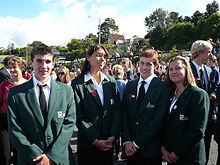Education in New Zealand
The study found that people in New Zealand lack basic knowledge in English, maths, science, geography, and history.
These wānanga were usually run by elders called tohunga, respected for their tribal knowledge and teaching was confined to the rangatira (chiefly) class.
[18] Victorian ideals had an influence on New Zealand education and schools even if open to both genders would often separate boys and girls.
Disabled students with special educational needs can attend day specialist schools until the end of the calendar year they turn 21.
The New Zealand Curriculum and Te Marautanga o Aotearoa have eight levels, numbered 1 to 8, and eight major learning areas: English (NZC) or Māori (TMoA), the arts, health and physical education, learning languages (which includes Māori in NZC and English in TMoA), mathematics and statistics, science, social sciences, and technology.
[27] Private schools receive less funding from the government and rely heavily on tuition fees paid by students' parents to operate, typically around NZ$20,000 per year.
Schools could operate a roll limit if there was a risk of overcrowding, but enrolments under this scheme were on a "first come, first served" basis, potentially excluding local students.
The Education Amendment Act 2000, enacted by the Fifth Labour Government, partially solved this problem by putting in place a new "system for determining enrolment of students in circumstances where a school has reached its roll capacity and needs to avoid overcrowding."
In addition, there is evidence that property values surrounding some more desirable schools become inflated, thus restricting the ability of lower socio-economic groups to purchase a house in the zone.
Schools are now requesting rates invoices, tenancy agreements, or power and telephone bills from parents to prove their residential address,[42] Some schools have gone as far as requiring parents to make a statutory declaration before a Justice of the Peace or similar that they live in the school zone, which makes it impossible for a parent to cheat the zone without also committing a criminal offence (making a false statutory declaration is punishable by up to three years' imprisonment[43]).
It was not until the Native Schools Act was passed in 1867 that a systematic government preference was articulated for the English language as a medium of instruction for Māori children.
In the early 1930s the director of Education blocked an initiative by the New Zealand Federation of Teachers to have the Māori language added to the curriculum.
[47] In 2022 the statistics in mainstream schooling for Māori students were that 35% left with NCEA level 3, compared to 58% at a kura kaupapa.
[53] In response to growing criticism that New Zealand's education system was too focused on academics and not providing practical skills to children the Liberal Government of New Zealand passed the Manual and Technical Elementary Instruction Act 1895 to establish classes that taught manual and technical skills to students as part of the curriculum.
Most secondary schools did not wish to change their curriculum as the prevailing belief amongst teachers was in support of academic education.
Typically parents will also outlay $500–$1000 per year for uniforms, trips, social events, sporting equipment and stationery at state schools.
Unlike voluntary donations, attendance dues are not optional and parents are contractually and legally required to pay them, and schools can take action to collect these or cancel the enrolment of a student if they are not paid.
The salaries are fixed nationwide, and are based on the teacher's qualifications, years of service and workload, with middle and senior management awarded extra pay through "units".
Most tertiary education students rely on some form of state funding to pay for their tuition and living expenses.
Secondary school students sitting the state run examinations are awarded scholarships, depending on their results, that assist in paying some tuition fees.
Universities and other funders also provide scholarships or funding grants to promising students, though mostly at a postgraduate level.
Student Allowances, which are non-refundable grants to students of limited means, are means tested and the weekly amount granted depends on residential and citizenship qualifications, age, location, marital status, dependent children as well as personal, spousal or parental income.
On 26 July 2005, the Labour Party announced that they would abolish interest on Student Loans, if re-elected at the September election, which they were.
Instead, the new teaching methods appear to have "confused teachers, children and parents by presenting multiple alternative problem-solving strategies but neglecting basic knowledge" and over the next few years New Zealand's rating dropped even further.
In December 2012, the latest TIMSS survey found New Zealand 9-year-olds ranked 34th out of 53 countries — and were bottom equal among developed nations.
Ministry of Education figures show the number of 12-year-olds who were able to answer simple multiplication questions correctly dropped from "47% in 2001 — the year new maths teaching methods were introduced — to 37% in 2009".
The report assesses performance rates of pupils in reading, writing and maths and is based on data from the Organisation for Economic Co-operation and Development.
[62] On a more general note, the Pearson report said the quality of teaching was key factor in a successful education system but also highlighted the importance of an underlying culture focused on children's learning.
Post Primary Teachers' Association president Robin Duff said the report illustrated a systemic failure by the Ministry of Education to help schools deal with bullying.
In March 2013, Secondary Principals Association president Patrick Walsh asked the Ministry to "urgently draft a comprehensive bullying policy for schools, after being surprised to find it did not have one."


